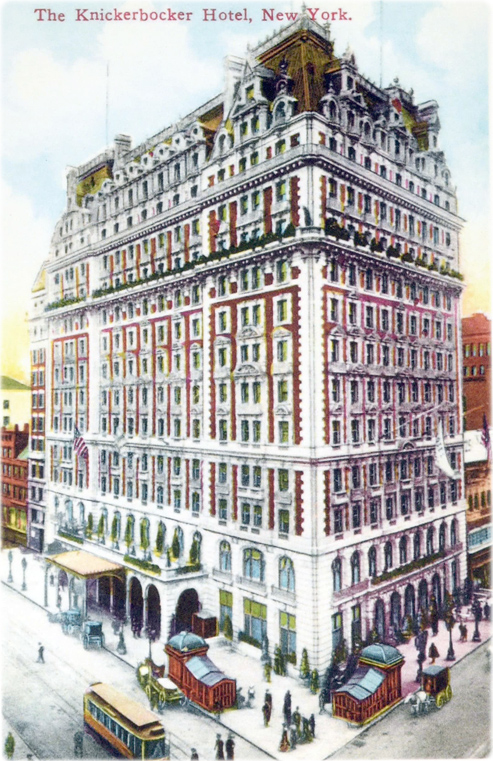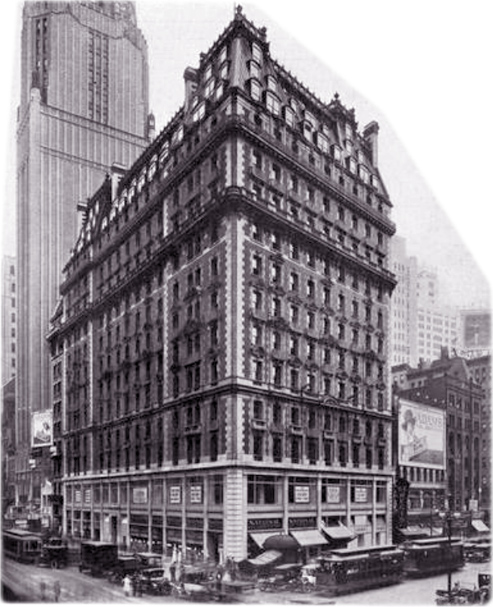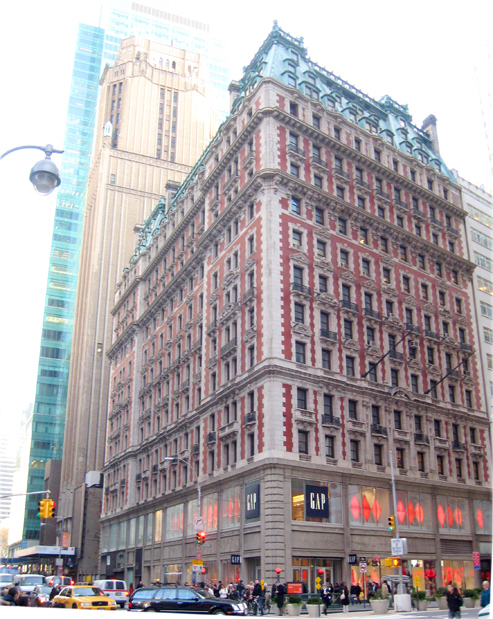
Knickerbocker Hotel
The Knickerbocker Hotel is located in the southeast corner of Broadway and 42nd Street, at 6 Times Square (1462–1470 Broadway). The 15-story hotel opened in 1906, two years after the Times Building and its Subway Times Station were completed. The hotel closed in 1920 and the structure was transformed into an office building. Knickerbocker Hotel reopened in 2015.
In the late 19th century and early 20th century, the area around Broadway and 42nd Street was growing rapidly and there were a few big hotels around, like the 7-story Rossmore Hotel (since 1876) on Broadway, between the 41st and 42nd streets, the 9-story Hotel Vendome (later Hotel Continental), on the southeast corner of West 41st Street and Broadway, the 7-story Stuart House (later Hotel Calvert), on the northeast corner of W 41st Street and Broadway, the 14-story Hotel Manhattan completed in 1896, on the northwest corner of Madison Avenue and 42nd Street and the 9-story Pabst Hotel completed in 1899, on the northern side of 42nd Street, between Broadway and 7th Avenue. The older and smaller, but charming 5-story St. Cloud Hotel opened in 1868, on the southeast corner of Broadway and W 42nd Street.
In 1892, John Jacob Astor IV, a real estate tycoon, took over the lease of the St. Cloud Hotel. Rand brothers continued as proprietors. The property included two four-story brownstone houses adjoining on 42nd Street and a narrow vacant plot in the rear at 143 West 41st Street. In 1893, Astor contracted Philip C. Brown to design an annex to the hotel at 143 West 41st Street, completed in 1894.
Later Astor gave a long term lease on the property to a group of investors, led by J.E. Pennock, who wanted to build a larger hotel on the site. The new hotel was designed in 1901 by the firm of Marvin & Davis with Bruce Price (1845-1903) as consulting architect. The new building application was filed in the same year. It was stipulated that the Annex at 143 West 41st Street remained a part of the hotel.
Knickerbocker Hotel Company was formed to build the hotel and J.J. Astor select James B. Regan as hotel manager, former manager of the Pabst Hotel, demolished to make way for Times Building.
By 1900, there was the Knickerbocker Hotel Restaurant at 384 and 385 West Street, opposite Christopher Street Ferry, in Manhattan. Knickerbockers are a loose trousers that fit tightly below the knee. The word Knickerbocker is informally used for a descendant of New York's early Dutch settlers. Since the 19th century, several institutions used this word as part of their names, including Knickerbocker Hospital, Knickerbocker Theatre, Knickerbocker magazine, Knickerbocker Trust Company and the Knickerbocker Whist Club, which had its headquarters in the St. Cloud Hotel Annex in 1897. The figure of "Father Knickerbocker", based on a character by writer Washington Irving (1783-1859), has been used as a civic personification of New York City, since 19th century.
The St. Cloud Hotel was demolished in 1902. Construction of the Knickerbocker began the same year and the name had already been chosen (see Projected Knickerbocker - 1902). By early 1904, the steel and masonry structure had been completed, when disagreements between the investors and Regan led to work being halted. Construction resumed in June of 1905, after architecture firm Trowbridge & Livingston was contracted to complete the work. The same firm was hired to design the St. Regis Hotel. The interior architecture was redesigned and a two-story portico was added to the 42nd Street façade.
According to the New York Times (September 5, 1905), after arriving from England, James B. Regan declared that the Knickerbocker would contain "all that's worth having" and that it would be "a thoroughly American institution", "the plans for the interior of the structure have undergone sweeping revision. The cost of construction, originally estimated at $2,250,000, has been raised to $3,500,000."
The 15-story Hotel was designed in the Beaux-Arts style. It was built in red brick, richly ornamented with French Renaissance detail, and crowned by a prominent copper mansard roof with corner pavilions and cresting. The façades on Broadway and 42nd Street are adorned by a series of balconies, cornices, classical pediments and highly ornamented windows. The structure is crowned by a three-story green copper mansard roof punctuated with segmental-arched dormer windows and topped with its original corner urns and cresting. Four brick and stone chimneys mark the corners of the pavilions, rising above the roofline on the 42nd Street façade.
The hotel had 556 sleeping rooms, 400 baths, six passenger elevators, tea rooms, restaurant, cafe, nurses' hall, a grill room with its own bar in the basement, barber's and manicure parlors, flower room, banquet rooms, private dining rooms, summer terrace and other facilities. The large ballroom rising through two stories.
It also had a private entrances from the Subway. Its large restaurants and bar-rooms were finely decorated with murals by noted artists such as Maxfield Parrish (1870-1966), Frederic Remington (1861-1909) and Charles Finn. Parrish was the painter of the iconic figure of "Old King Cole" in the entrance hall. Sculptor Frederick MacMonnies (1863-1937) was commissioned to design two electrified fountains. The main dining room on the ground floor had the capacity for 2,000 guests and it was decorated after French designs, with rich tapestries and beamed ceiling. There was a secondary entrance to the Cafe on Broadway. The entire scheme of interior decoration and furnishing was in charge of James Wall Finn, associated with Trowbridge & Livingston.
The Knickerbocker Hotel opened to invited guests on October 23, 1906, by John Jacob Astor IV. The next day it opened for business. The manager James B. Regan referred to the hotel as " a Fifth Avenue Hotel at Broadway prices". The hotel soon became a place for lavish parties and nightlife. It had some famous residents, like the tenor Enrico Caruso, who lived there until he died in 1921.
In 1908-10 architect C.H. Cullen added a penthouse which was to be used for upholstery repair. In 1911 the portico on the sidewalk level of 42nd Street was removed.
By April 1920, with Prohibition in effect, James B. Regan sold the hotel. He had been the lessee and manager from the beginning. On May 10, Regan announced that he would retire and the Knickerbocker Hotel would be closed on May 30 (Decoration Day), which it did. It was converted into an office building. Regan sold the furnishings in June.
The Knickerbocker Holding Company was formed for the purpose of taking over the lease of the hotel from Regan and altering it to commercial and office use. The directors were Vincent Astor, Nicholas Biddle and S.B. Thorn. The reform began the same year. Changes were made under architect Charles A. Platt (1861-1933), specially in the first two floors. All the rich marbles were torn out and the interior fittings and equipment of the hotel were removed. On the the exterior, the balustrade on the cornice above the ninth floor and the iron railing on the upper cornice, were removed. The dormer window enframents were replaced with simple segmental-arched lintels. A third story of dormers was installed and the tile covering the top of the mansard was removed. Later anodized aluminum one-over-one sash windows were installed above the second story.
In 1921, after the conversion to retail and office space, the structure was known as the Knickerbocker Building. At that time, The Knickerbocker Grill was one of the fashionable restaurants in the City.
From 1940 to 1959 it was called the Newsweek Building, after the major tenant, Newsweek magazine. The first two floors were modified a few times since 1920. In 1979 the main entrance was changed to 1466 Broadway. Later, the building was renamed "Six Times Square".
On September 24, 1925, thirty federal agents descended on the Knickerbocker and Longacre buildings and 13 people were seized in offices. Wrrants for the arrest of 14 more defendants were issued. The two raids were timed simultaneously.
Another Hotel Knickerbocker at 120 West 45th Street opened in 1925 and closed in the 1980s.
In 1980 the building was added to the National Register of Historic Places. According to the New York Times (July 28, 1999), about that time, Harry B Helmsley and David Baldwin began converting the building to residential lofts, but soon after they marketed 1466 Broadway as a showroom center.
In 1988, the building was designated a New York City Landmark for its special historical and aesthetic interest and value as part of the development, heritage and cultural characteristics of New York City.
In 1998, S L Green Realty Corporation purchased the building with the intention of turning it back into a hotel. At the time its tenants were mostly sportswear manufacturers and, in 1999, its façade on 42nd Street was covered by gigantic billboards.
In 2010, Ashkenazy, Crown Acquisitions and Highgate Holdings bough the property, which was owned by the royal family of Dubai. The building was renovated trying to revive some of the old architecture. On February 12, 2015, Knickerbocker Hotel reopened and its rooftop bar (former Summer Terrace), overlooking Times Square, was named after the 19th century St. Cloud Hotel. The old St. Cloud Hotel Annex on West 41st Street still stands today.


|
Copyright © Geographic Guide - Historic Hotels in NYC. |
Knickerbocker Hotel on the corner of Broadway and 42nd Street. Vintage postcard published in the early 20th century (before 1911) by Success Postal Card Company.

Six Times Square, looking southeast across Broadway and 42nd Street, with Bush Tower and 1095 Avenue of the Americas in background. Photo taken on a cloudy afternoon on 18 December 2008 by Jim Henderson.
The Knickerbocker Building in 1921, after reform to transform the old hotel into office building. Source: Architecture and Building, November, 1921.
Knickerbocker Hotel
